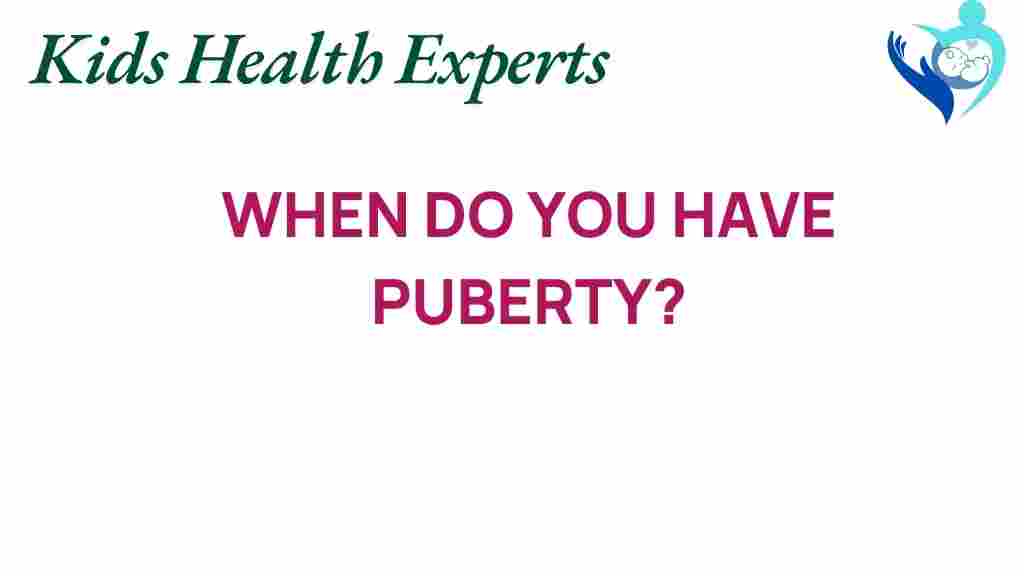Unraveling the Mystery: When Does Puberty Truly Begin?
Puberty is a significant phase in human development that marks the transition from childhood to adulthood. It involves a series of physical, emotional, and hormonal changes that lead to sexual maturity. Understanding when puberty begins, the age range, and the associated milestones can help both parents and adolescents navigate this complex time.
Understanding Puberty
Puberty is a critical period characterized by growth and development. It typically begins between the ages of 9 and 14 for girls and 10 and 15 for boys. The onset of puberty can vary significantly from one individual to another, influenced by genetics, nutrition, and environmental factors.
Signs of Puberty
Recognizing the signs of puberty can help adolescents and their families prepare for the changes ahead. Some of the initial signs include:
- Growth Spurts: A noticeable increase in height is often one of the first signs.
- Body Hair: The development of pubic and underarm hair usually follows.
- Breast Development: For girls, breast buds may begin to form, often the first physical sign of puberty.
- Menstrual Cycle: Girls typically experience their first menstrual period (menarche) around two years after the onset of breast development.
- Voice Changes: Boys often experience a deepening of the voice as their larynx grows.
The Role of Hormonal Changes
Hormonal changes are at the core of puberty. The hypothalamus signals the pituitary gland to release hormones that stimulate the gonads (ovaries in girls and testes in boys) to produce sex hormones such as estrogen and testosterone. These hormones are responsible for the physical changes that occur during this time.
Milestones of Puberty
Puberty is divided into stages, each with distinct milestones:
- Early Puberty (9-11 for girls, 10-12 for boys): Initial signs such as breast budding in girls or testicular enlargement in boys.
- Middle Puberty (12-14 for girls, 13-15 for boys): Growth spurts, body hair development, and the onset of menstruation for girls.
- Late Puberty (15-17 for girls, 16-18 for boys): Completion of growth and development of secondary sexual characteristics.
Physical Changes During Puberty
The physical changes during puberty are profound and can be categorized into several areas:
Growth and Height
During puberty, adolescents can experience significant growth spurts. Girls often reach their adult height by approximately 16 years of age, while boys may continue to grow until around 18 or 19.
Sexual Development
For boys, puberty brings about increased muscle mass, broader shoulders, and the growth of facial and body hair. Girls will see the development of breasts and wider hips, preparing their bodies for potential childbirth.
Skin and Hair Changes
Many adolescents experience changes in their skin due to increased oil production, leading to issues like acne. Hair texture may also change during puberty.
Age Range for Puberty
While the average age range for the onset of puberty is generally well-known, it is crucial to remember that individual variations are common. Some children may start earlier or later, and this can still fall within the normal spectrum. Here’s a quick overview:
- Girls: 9 to 14 years
- Boys: 10 to 15 years
Factors Influencing the Onset of Puberty
Several factors can influence when puberty begins:
- Genetics: Family history can play a significant role in determining the age of onset.
- Nutrition: A well-balanced diet can support healthy growth and development.
- Environmental Factors: Exposure to certain chemicals and stress can impact hormonal balance.
Step-by-Step Process of Puberty
Puberty is not a singular event but a series of changes that occur over several years. Here’s a step-by-step breakdown:
- Initiation: The brain begins to signal the body to start the process, often triggered by various internal and external factors.
- Hormonal Release: The pituitary gland releases hormones that stimulate the gonads.
- Physical Changes: Adolescents begin to experience various physical changes, including growth spurts and development of sexual characteristics.
- Emotional Changes: Alongside physical changes, adolescents may experience mood swings and emotional fluctuations due to hormonal changes.
- Completion: The body reaches sexual maturity, and physical growth stabilizes.
Troubleshooting Tips for Parents and Guardians
As a parent or guardian, it’s natural to have concerns about your child’s development during puberty. Here are some tips to help you navigate this journey:
- Open Communication: Encourage open dialogue about the changes they are experiencing. This can help alleviate fears and confusion.
- Education: Provide age-appropriate information about puberty, including physical and emotional changes.
- Monitor Development: Keep track of your child’s growth patterns and consult a healthcare provider if there are any concerns.
- Support Emotional Health: Be aware that this period can be challenging emotionally. Offer support and understanding.
Conclusion
Puberty is a complex and transformative stage of life that involves numerous hormonal changes, physical alterations, and emotional developments. By understanding the signs and age range associated with puberty, parents and adolescents can better navigate the challenges that arise during this time. Remember, every child develops at their own pace, and what matters most is providing support and guidance throughout this journey.
For more information on child development, check out this resource.
Embrace the changes, communicate openly, and remember that puberty is a natural part of growing up!
This article is in the category Growth and created by KidsHealthExperts Team

1 thought on “Unraveling the Mystery: When Does Puberty Truly Begin?”